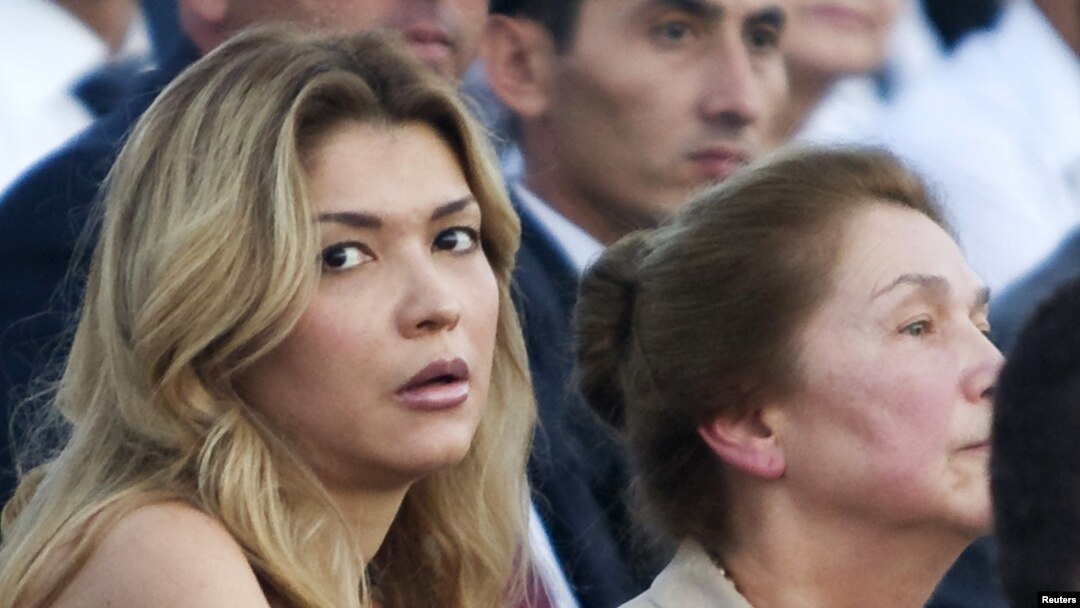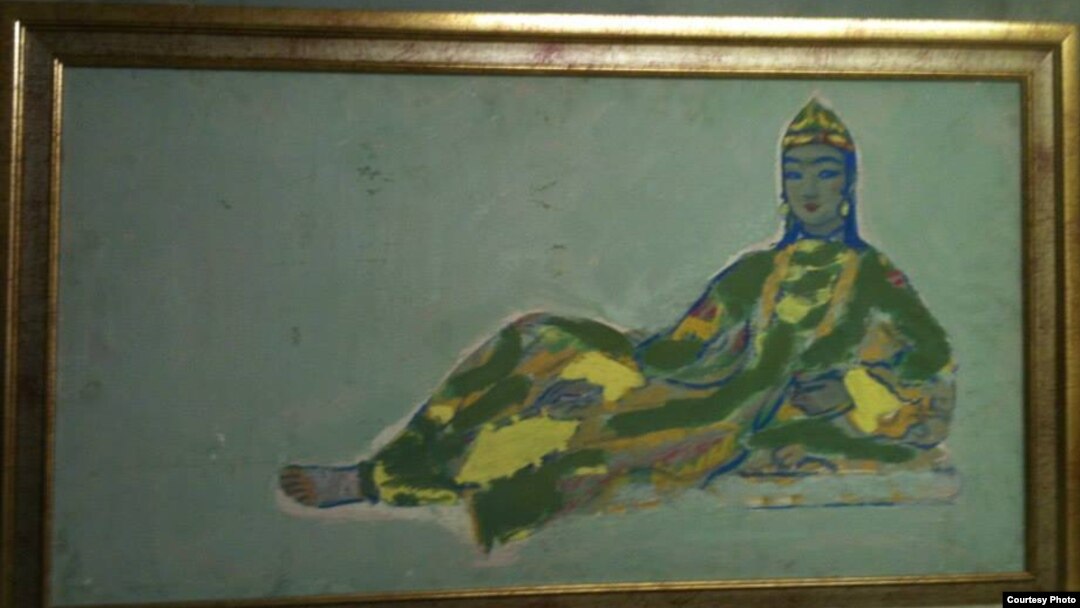Uzbek first daughter Gulnara Karimova has never hidden her appreciation of art.
What she may have been hiding, however, is the art itself.
An Uzbek dissident currently occupying Karimova's $20-million Geneva mansion says he has uncovered a treasure trove of 20th-century paintings pilfered from Uzbekistan's state art museums.
Safar Bekjan, an Uzbek political refugee, illegally entered Karimova's home on December 23 together with four fellow dissidents.
Since then, he has posted online photographs of what he says are hundreds of luxury items, including gold and diamond jewelry, a Bentley automobile, and an 18th-century Koran inlaid with precious stones.
Perhaps more importantly, Bekjan also claims to have uncovered more than 60 museum artworks -- including rare pieces like "Beauty," a 1980 masterwork by Chingiz Akhmarov, a People's Artist of Uzbekistan, as well as paintings by celebrated artists, such as Viktor Ufimtsev and Ruzi Choriev.
Bekjan told RFE/RL's Uzbek Service, Radio Ozodlik, that he entered the house looking to document Karimova's excesses, but was shocked to find the art, much of which was stored in the attic.

"There was a hole leading to the villa's attic, and there on the walls there were different paintings," he said. "There was a huge painting, 'Pomegranate,' by Lev Reznikov. After I took the painting off the wall I saw the inscriptions proving it was his. I was very surprised -- how did it get there? I looked for more details, but there were no special inscriptions or indications, such as a Culture Ministry [transport] statement. It looks like it just got here on its own."
Bekjan's sometimes blurry photographs, which are posted online, include close-up shots of artists' signatures, and in some cases, what appear to be museum stamps.
Two Uzbek art experts, Sergei Ignatiev and Boris Chukhovich, who have seen the original works in their museum settings in Tashkent, told Ozodlik that they believed the paintings photographed by Bekjan were authentic.
'Gems' Of Uzbek Culture
A former high-ranking official with the Uzbek Culture and Sports Ministry, which oversees all museum holdings, confirmed to Radio Ozodlik that the original paintings had vanished from state collections "under pressure from Opa" -- a reference to the Uzbek word for "big sister," as Karimova is commonly known among the Uzbek public.
The official added that "hundreds" of artworks had been surreptitiously moved out of the country, many via special exhibits sponsored by Karimova's Fund Forum charity. The official described the vanished works as the "gems" of Uzbek culture.
If the paintings prove to be authentic, it will be the latest strike against the 41-year-old Karimova, described in U.S. diplomatic cables as a "robber baron" who has used her position of power to squeeze millions in assets from Uzbek businesses and foreign investors.
Karimova, a former UN ambassador, has been tied to ongoing money-laundering investigations in Sweden and Switzerland.
But her once-untouchable status has also begun to suffer at home, with local prosecutors shutting down a number of her media and cultural enterprises, apparently at the behest of her father, autocratic leader Islam Karimov.
PHOTO GALLERY: Uzbek Treasures In A Geneva Attic
Speculation is rife that that the dissident raid in Geneva is sanctioned by the Uzbek state as well. Bekjan has admitted he entered the home with a key, but has refused to say who provided it to him.
Karimova, a volatile, unabashed presence on Twitter, has accused Uzbekistan's SNB security services of providing Bekjan with the key.
The SNB, it is suggested, obtained the key from Karimova's estranged sister, Lola Kairmova-Tillyaeva, who in recent months has waged a high-profile media campaign seeking to distance herself from the alleged crimes of her older sister.
Museums Are Keeping Silent
Swiss police have visited the Geneva house but have not attempted to remove Bekjan from the premises.
Uzbek diplomatic officials paid an initial visit to the house on December 24, but left only with the Bentley and a high-range Mercedes, taking little notice of the art.
According to Bekjan, they returned on December 27 and began cataloguing the artworks, some of which are valued in the hundreds of thousands of dollars.
None of the Tashkent state museums contacted by Radio Ozodlik would comment on the disappeared paintings.
But Igor Reznik, the son of Lev Reznikov, the late author of "Pomegranate," told RFE/RL that he was deeply concerned about his father's work, which was sold to Tashkent's State Museum of Art in 1990 with no right of resale.
"It's a museum item," he said. "It should be in a museum. When my father sold it, it was clear that he was selling it to a museum. So I think it's the museum that should answer for how this picture ended up [in Geneva]. If the museum didn't need it anymore, if they just wanted to get rid of it, then I'm the first person who would be happy to have it. It's my father's work."
Karimova may have been happy to have it as well. With its sumptuous, ruby-red seeds, the pomegranate -- known as "anor" in Uzbek -- is said to be one of the favored design motifs of Karimova, whose first name translates loosely as "pomegranate flower."
What she may have been hiding, however, is the art itself.
An Uzbek dissident currently occupying Karimova's $20-million Geneva mansion says he has uncovered a treasure trove of 20th-century paintings pilfered from Uzbekistan's state art museums.
Safar Bekjan, an Uzbek political refugee, illegally entered Karimova's home on December 23 together with four fellow dissidents.
Since then, he has posted online photographs of what he says are hundreds of luxury items, including gold and diamond jewelry, a Bentley automobile, and an 18th-century Koran inlaid with precious stones.
Perhaps more importantly, Bekjan also claims to have uncovered more than 60 museum artworks -- including rare pieces like "Beauty," a 1980 masterwork by Chingiz Akhmarov, a People's Artist of Uzbekistan, as well as paintings by celebrated artists, such as Viktor Ufimtsev and Ruzi Choriev.
Bekjan told RFE/RL's Uzbek Service, Radio Ozodlik, that he entered the house looking to document Karimova's excesses, but was shocked to find the art, much of which was stored in the attic.

Gulnara Karimova
"There was a hole leading to the villa's attic, and there on the walls there were different paintings," he said. "There was a huge painting, 'Pomegranate,' by Lev Reznikov. After I took the painting off the wall I saw the inscriptions proving it was his. I was very surprised -- how did it get there? I looked for more details, but there were no special inscriptions or indications, such as a Culture Ministry [transport] statement. It looks like it just got here on its own."
Bekjan's sometimes blurry photographs, which are posted online, include close-up shots of artists' signatures, and in some cases, what appear to be museum stamps.
Two Uzbek art experts, Sergei Ignatiev and Boris Chukhovich, who have seen the original works in their museum settings in Tashkent, told Ozodlik that they believed the paintings photographed by Bekjan were authentic.
'Gems' Of Uzbek Culture
A former high-ranking official with the Uzbek Culture and Sports Ministry, which oversees all museum holdings, confirmed to Radio Ozodlik that the original paintings had vanished from state collections "under pressure from Opa" -- a reference to the Uzbek word for "big sister," as Karimova is commonly known among the Uzbek public.
The official added that "hundreds" of artworks had been surreptitiously moved out of the country, many via special exhibits sponsored by Karimova's Fund Forum charity. The official described the vanished works as the "gems" of Uzbek culture.
If the paintings prove to be authentic, it will be the latest strike against the 41-year-old Karimova, described in U.S. diplomatic cables as a "robber baron" who has used her position of power to squeeze millions in assets from Uzbek businesses and foreign investors.
Karimova, a former UN ambassador, has been tied to ongoing money-laundering investigations in Sweden and Switzerland.
But her once-untouchable status has also begun to suffer at home, with local prosecutors shutting down a number of her media and cultural enterprises, apparently at the behest of her father, autocratic leader Islam Karimov.
PHOTO GALLERY: Uzbek Treasures In A Geneva Attic
Uzbek Treasures In A Geneva Attic
Speculation is rife that that the dissident raid in Geneva is sanctioned by the Uzbek state as well. Bekjan has admitted he entered the home with a key, but has refused to say who provided it to him.
Karimova, a volatile, unabashed presence on Twitter, has accused Uzbekistan's SNB security services of providing Bekjan with the key.
The SNB, it is suggested, obtained the key from Karimova's estranged sister, Lola Kairmova-Tillyaeva, who in recent months has waged a high-profile media campaign seeking to distance herself from the alleged crimes of her older sister.
Museums Are Keeping Silent
Swiss police have visited the Geneva house but have not attempted to remove Bekjan from the premises.
Uzbek diplomatic officials paid an initial visit to the house on December 24, but left only with the Bentley and a high-range Mercedes, taking little notice of the art.
According to Bekjan, they returned on December 27 and began cataloguing the artworks, some of which are valued in the hundreds of thousands of dollars.
None of the Tashkent state museums contacted by Radio Ozodlik would comment on the disappeared paintings.
But Igor Reznik, the son of Lev Reznikov, the late author of "Pomegranate," told RFE/RL that he was deeply concerned about his father's work, which was sold to Tashkent's State Museum of Art in 1990 with no right of resale.
"It's a museum item," he said. "It should be in a museum. When my father sold it, it was clear that he was selling it to a museum. So I think it's the museum that should answer for how this picture ended up [in Geneva]. If the museum didn't need it anymore, if they just wanted to get rid of it, then I'm the first person who would be happy to have it. It's my father's work."
Karimova may have been happy to have it as well. With its sumptuous, ruby-red seeds, the pomegranate -- known as "anor" in Uzbek -- is said to be one of the favored design motifs of Karimova, whose first name translates loosely as "pomegranate flower."


